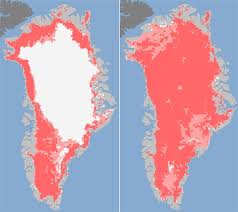 These undated handout images provided by NASA shows the extent of surface melt over Greenland’s ice sheet on July 8, left, and July 12, right. Measurements from three satellites showed that on July 8, about 40 percent of the ice sheet had undergone thawing at or near the surface. In just a few days, the melting had dramatically accelerated and an estimated 97 percent of the ice sheet surface had thawed by July 12. In the image, the areas classified as “probable melt” (light pink) correspond to those sites where at least one satellite detected surface melting. The areas classified as “melt” (dark pink) correspond to sites where two or three satellites detected surface melting. Nearly every part of the massive Greenland ice sheet suddenly and strangely melted a bit this month in a freak event that concerned scientists had never witnessed before. NASA says three different satellites saw what it calls unprecedented melting from July 8 to July 12. Most of the thick ice remains, but what was unusual was the widespread area where some melting occurred. (AP Photo/Nicolo E. DiGirolamo, SSAI/NASA GSFC, and Jesse Allen, NASA Earth ObservatoryBy SETH BORENSTEIN
These undated handout images provided by NASA shows the extent of surface melt over Greenland’s ice sheet on July 8, left, and July 12, right. Measurements from three satellites showed that on July 8, about 40 percent of the ice sheet had undergone thawing at or near the surface. In just a few days, the melting had dramatically accelerated and an estimated 97 percent of the ice sheet surface had thawed by July 12. In the image, the areas classified as “probable melt” (light pink) correspond to those sites where at least one satellite detected surface melting. The areas classified as “melt” (dark pink) correspond to sites where two or three satellites detected surface melting. Nearly every part of the massive Greenland ice sheet suddenly and strangely melted a bit this month in a freak event that concerned scientists had never witnessed before. NASA says three different satellites saw what it calls unprecedented melting from July 8 to July 12. Most of the thick ice remains, but what was unusual was the widespread area where some melting occurred. (AP Photo/Nicolo E. DiGirolamo, SSAI/NASA GSFC, and Jesse Allen, NASA Earth ObservatoryBy SETH BORENSTEIN
updated 7/24/2012 5:54:45 PM ET 2012-07-24T21:54:45
Print Font: +-WASHINGTON — Nearly all of Greenland’s massive ice sheet suddenly started melting a bit this month, a freak event that surprised scientists.
Even Greenland’s coldest and highest place, Summit station, showed melting. Ice core records show that last happened in 1889 and occurs about once every 150 years.
Three satellites show what NASA calls unprecedented melting of the ice sheet that blankets the island, starting on July 8 and lasting four days. Most of the thick ice remains. While some ice usually melts during the summer, what was unusual was that the melting happened in a flash and over a widespread area.
“You literally had this wave of warm air wash over the Greenland ice sheet and melt it,” NASA ice scientist Tom Wagner said Tuesday.
The ice melt area went from 40 percent of the ice sheet to 97 percent in four days, according to NASA. Until now, the most extensive melt seen by satellites in the past three decades was about 55 percent.
Wagner said researchers don’t know how much of Greenland’s ice melted, but it seems to be freezing again.
“When we see melt in places that we haven’t seen before, at least in a long period of time, it makes you sit up and ask what’s happening?” NASA chief scientist Waleed Abdalati said. It’s a big signal, the meaning of which we’re going to sort out for years to come.”
About the same time, a giant iceberg broke off from the Petermann Glacier in northern Greenland. And the National Snow and Ice Data Center on Tuesday announced that the area filled with Arctic sea ice continues near a record low.
Wagner and other scientists said because this Greenland-wide melting has happened before they can’t yet determine if this is a natural rare event or one triggered by man-made global warming. But they do know that the edges of Greenland’s ice sheets have already been thinning because of climate change.
Summer in Greenland has been freakishly warm so far. That’s because of frequent high pressure systems that have parked over the island, bringing warm clear weather that melts ice and snow, explained University of Georgia climatologist Thomas Mote.
He and others say it’s similar to the high pressure systems that have parked over the American Midwest bringing record-breaking warmth and drought.
Ohio State University ice scientist Jason Box, who returned Tuesday from a three-week visit, said he ditched his cold weather gear for the cotton pants that he normally dons in Nevada.
“It was sunny and warm and all the locals were talking about how sunny it was,” Box said after getting off a plane. “Beyond T-shirt weather.”
